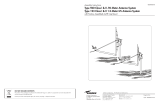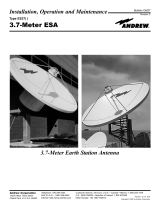Page is loading ...

GENERAL INFORMATION
The DB201 antenna features a unique molded epoxy feed-
through insulator. This design affords easy replacement of
the connecting lead by means of a male-to-female connec-
tion which is completely protected from the weather.
Unless otherwise specified when ordering, each antenna is
cut to frequency at the factory and adjusted for minimum
VSWR. As a result, no field tuning or adjustment is required.
If ordered uncut, a cutting chart is provided separately.
These antennas are designed for mounting above the top of
a tower or wooden pole, and best operation is obtained when
the ground plane rods are above all objects.
Should metal objects extend above the level of the ground
plane (or it is necessary to mount the antenna on the side of
a tower) the radiation pattern will be distorted. The shape of
the pattern will depend on the frequency of operation, the
size of the tower, and the distance between the antenna and
tower. Radiation "through the tower" will be lower than from
other directions. If a more specific pattern is desired, please
contact Andrew’s Applications Engineering with tower and
mounting specifics.
INSTALLATION INSTRUCTIONS
1. After removing the antenna from the shipping box, in-
spect it to ensure all parts are on hand and that there is
no physical damage.
2. Inspect the antenna feed output connector to determine
that it mates with the end of your station transmission
line.
3. Verify that the frequency to which the antenna has been
tuned is the frequency on which your radio system is to
operate.
4. Mount the antenna to the support pipe using the DB365
mounting clamp(s), supplied with the antenna. This
clamp fits round members from 1-1/4” to 3” OD and
angle members up to 2-1/2” on a side. A single clamp is
provided with DB201 antennas at frequencies above
Figure 1. DB201 Antenna; Inset - DB365-OS Clamp
Installation Instructions
Bulletin 095001-000
Revision K • November 2003 • Page 1 of 2
Ground Plane Omni Antenna
DB201 Series
Do not install near power lines. Power lines,
telephone lines, and guy wires look the same.
Assume any wire or line can electrocute you.
Do not install on a wet or windy day or when
lightning or thunder is in the area. Do not use
metal ladder.
Wear shoes with rubber soles and heels.
Wear protective clothing including a long-
sleeved shirt and rubber gloves.
(continued on page 2)

Bulletin 095001-000 • Revision K • November 2003 • Page 2 of 2
DB201 Ground Plane Omni Antenna Andrew Corporation
the outer jackets of the transmission line. Failure to wa-
terproof the cable connection will result in improper op-
eration of the antenna.
9. Secure the feeder cable and antenna transmission line
to the tower in the best position as to avoid physical
damage to the cable.
10. After the antenna and transmission line installation has
been completed, a careful visual check should be made
to ensure that:
• All mechanical connections have been securely made.
• All connections have been securely wrapped with
VAPOR-WRAP™ to prevent moisture problems.
Continued from page 1
120 MHz. Two clamps are provided with DB201 anten-
nas in the 30-120 MHz frequency range. Tighten the
mounting clamps securely and evenly. If two clamps
are used, ensure that the clamps are vertically aligned.
5. Using the supplied lockwashers and nuts, install the U-
bolts onto the base plate, leaving them loose enough
that the ground radials can be placed between the U-
bolts and the base plate. Slide the radials in until they
touch against the side of the adjacent U-bolt. Then,
tighten the U-bolts securely and evenly.
6. Mount the fully assembled antenna onto the tower en-
suring that the antenna is vertical and that the mount-
ing clamps are tightened evenly and securely.
7. It is recommended that a check of the antenna VSWR
is measured at this point. Note this measurement care-
fully and record it for future reference.
8. After checking the VSWR at the antenna, connect the
station transmission line to the antenna. Make the con-
nection snug, but do not apply heavy force with pliers.
To prevent moisture problems, carefully wrap VAPOR-
WRAP™ (11317 or 11316) around the connection; work
ing the compound into all cracks and smoothing it over
Andrew Corporation
Base Station Antennas
8635 Stemmons Freeway
Dallas, TX U.S.A. 75247
Telephone: 1-800-676-5342
FAX (U.S.A.): 1-800-229-4706
Internet: www.andrew.com
Customer Service, 24 Hour: U.S.A. • Canada • Mexico: 1-800-255-1479
U.K.: 0800 250055
Other Europe: +44 1592 782612
Printed in U.S.A.
Copyright © 2003 by Andrew Corporation
MECHANICAL DATA
35 MHz 50 MHz 150 MHz 450 MHz
Materials:
Radiator Assy. 6063-T832 aluminum, 6063-T832 aluminum, 6063-T832 aluminum, 6063-T832 aluminum,
7/8” OD with 1/8” wall 7/8” OD with 1/8” wall 7/8” OD with 1/8” wall 7/8” OD with 1/8” wall
and 3/8” OD solid rod and 3/8” OD solid rod and 3/8” OD solid rod and 3/8” OD solid rod
Ground Radials 6061-T6 aluminum, 6061-T6 aluminum, 6061-T6 aluminum, 6061-T6 aluminum,
1/2” OD solid rod 1/2” OD solid rod 1/2” OD solid rod 1/2” OD solid rod
tapered to 1/4” OD tapered to 1/4” OD
Support Pipe Galvanized steel Galvanized steel Galvanized steel Galvanized steel
1-5/16” OD, 24” length 1-5/16” OD, 24” length 1-5/16” OD, 12” length 1-5/16” OD, 12” length
Mounting Clamps Galvanized steel Galvanized steel Galvanized steel Galvanized steel
Max. Exposed Area 1.1 ft² 0.8 ft² 0.4 ft² 0.3 ft²
(flat plate equivalent)
Wind Rating
Survival (w/o ice) 93 mph 122 mph Over 125 mph Over 125 mph
Survival (1/2” radial ice) 51 mph 65 mph Over 125 mph Over 125 mph
Lateral Thrust at 100 mph 45 lbs. 32 lbs. 16 lbs. 11 lbs.
(40 psf flat equivalent)
Bending Moment (2” below plate) 64 ft. lbs. 35 ft. lbs. 5 ft. lbs. 1 ft. lbs.
At 100 mph (40 psf flat equivalent)
Overall Length 101” 78” 30” 19”
Height (above base plate) 77” 54” 18” 6-1/2”
Max. Width (horizontal) 216” 151” 49” 15”
Net Weight 24 lbs. 22 lbs. 10 lbs. 6 lbs.
NOTICE
The installation, maintenance, or removal of an antenna
requires qualified, experienced personnel. Andrew installation
instructions are written for such installation personnel.
Antenna systems should be inspected once a year by qualified
personnel to verify proper installation, maintenance, and
condition of equipment.
Andrew disclaims any liability or responsibility for the results
of improper or unsafe installation practices.
/










